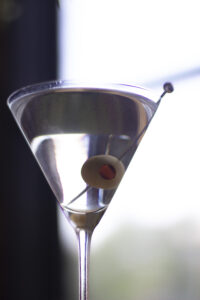If 2020 taught us anything, it’s that adaptability makes life easier. Of course, any Rochesterian who has experienced the transition between summer and autumn knew that already. Few places on Earth demand you wear a tank top layered with a fisherman’s sweater because even though it’s forty degrees right now, 4 p.m. could be a scorcher. What 2020 has also taught us is that sometimes, most times, a drink in your hand and a friend by your side mean everything. Fortunately, cocktails are fluid (ha) entities.
My personal favorite gap-bridging drinks are familiar to anyone with even a passing awareness that alcohol exists: the Martini and the Manhattan. These classics, simple and revered, are served everywhere from Death and Company to your corner pub. But that doesn’t make perfecting them any less challenging or rewarding. In fact, the straightforward nature of these cocktails is what makes their perfection so elusive. There’s nowhere to hide your mistakes. The Manhattan and Martini are delightful in this season between hot and cold. They are refreshing yet bracing. Comforting but steely. A warm embrace punctuated by a slap on the back.
Rumor has it the Manhattan got its start when Winston Churchill’s mother, Lady Randolph, threw a wild party at the Manhattan Club for a political hopeful in the 1870s. An unsung American hero, Dr. Iain Marshall, mixed rye, sweet vermouth, and Angostura bitters in a glass and started slinging drinks. The crème de la crème at the party got hammered and spread the word. Soon, people started asking bartenders for “that Manhattan (Club) cocktail.”
The Martini is, ironically, less clear than the Manhattan when it comes to origin stories. Most say it’s a spinoff of the Martinez cocktail from several bars in and around Martinez, California. Early recipes, however, don’t bear a strong resemblance to what we would recognize today. (Unless you order yours with curacao, gum syrup, Maraschino, and sweet vermouth. If you do, better skip this next section.)
There is a right way to make a Martini. It is with 2.25-2.5 ounces of London dry gin, 0.5-0.75 ounces of dry vermouth, stirred—yes, I say stirred—with ice until very cold, then strained into a Martini glass where it is crowned with either an olive or a lemon peel. The only acceptable addition is orange bitters, which corresponds with the earliest known dry Martini recipe from New York.
So, let’s get into it, shall we? Olive juice? No. Vodka? No. Shaken? Is your name James Bond? No? Then no. Am I a snob about this? Clearly, a resounding and enthusiastic yes. But I argue that in the world of cocktails, there is never a more noble hill to die upon than the Martini. Like a good friend, the perfect Martini is hard to find. It challenges as it comforts, and, like good times, your moments with it are fleeting, with the promise of many sweet returns.
If you shake a Martini, you introduce aerate and overdilute the delicate balance. Shake when there is citrus, yes, but stir when only spirits are present. Shaking also clouds the drink with tiny air bubbles, and one of the joys of this drink is its clarity. A Martini made with vodka is technically a Vodka Martini—it used to be called a Kangaroo, but that was just too silly. Then again, so is ordering a Martini with anything other than gin, but that’s just my opinion.
With the Manhattan I find much more acceptable variability. For example, some debate exists over whether the drink is best made with bourbon or rye. Both are whiskeys, just like Scotch, Irish, etc. The main difference is that bourbon is made with corn, and rye is made with … rye. So, to boil it down, bourbon is sweeter, and rye is spicier. Since I like drier drinks, I go with rye. I also like a Manhattan on the rocks rather than served up (like a Martini). This is unorthodox. I would also rather have a lemon or orange peel as a garnish instead of a cherry any day.
Both Manhattans and Martinis contain vermouth. By definition, vermouth is a fortified, aromatized wine. During production, a liquor, like grape brandy for example, boozes up the base wine. Then botanicals are added to evoke a veritable bouquet of flavors. Vermouths are all different, and most come at an outstanding price point for what they add to a drink. That said, spend the extra five bucks for a great bottle. Dolin, Noilly Prat, and Carpano all make very good sweet and dry vermouths. I would even recommend trying them on their own as a drink with some ice and a lemon peel or olive.
While many varieties exist, vermouths are often characterized as sweet or dry. Sweet (also called red or Italian vermouth), which is mostly produced in Italy and Spain, has a jam-like, more full-bodied flavor. Dry vermouth, famously produced in southern France, is sharply crisp and slightly more bitter. Treat both varieties like wine—once opened, vacuum seal, enjoy them inside of a month, and keep refrigerated.
Uncertainty in life is always challenging. But challenges are surmountable, especially when there’s a stiff drink in your hand. And no drinks are more versatile (whether we’re talking climate, occasion, or the general state of the world) than the Martini and the Manhattan. Cheers, enjoy, and here’s to heading for stable ground.
Pete Wayner is a food- and beverage-centric content creator based in Rochester.
Views: 1






